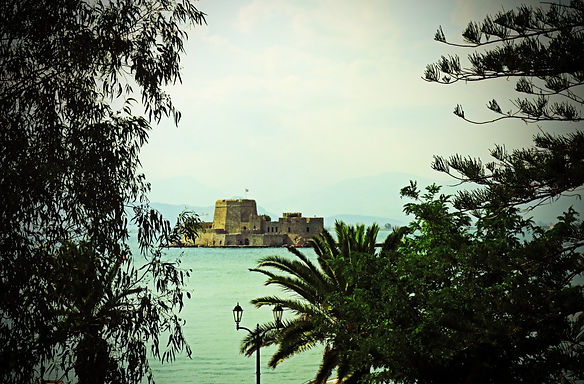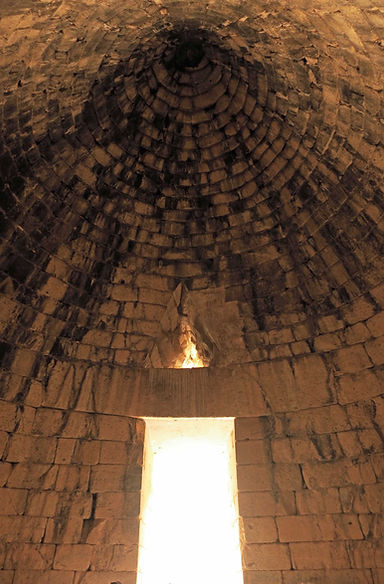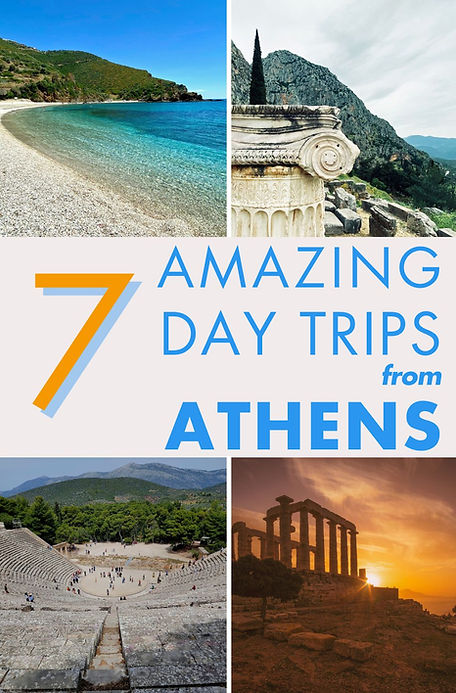
The Greekish Life
Travel
7 Perfect Day Trips from Athens

Temple of Apollo - Corinth
All photos by me unless otherwise credited.
If you know me or follow me on social media at all, you know I'm a big fan of the city of Athens. The archaeological treasures, the museums, the food, the nightlife, and the vibrancy make it my favorite city in the world, and I always encourage people not to rush out of Athens to get to the more glamorous islands. Stay a while and get to know it.
But you can also base yourself in Athens and still see some remarkable places on day trips!
You can certainly drive a rental car to all of these places, but if you're not someone who feels like they want to do that, there are multiple tours that will take care of the driving for you to most of these places, if you don't mind being in a group. Some busses go to many if you prefer to travel on your own but still don't want to have to do the driving.
Let's start with the closest one to Athens - stunning Cape Sounion.
1. Sounion
.jpg)
The Temple of Poseideon at Sounion
Photo by Unsplash
Sounion, sitting at the southernmost tip of Attica, is home to the beautiful temple of Poseidon. It was constructed from 444 to 440 BCE, during the ascendancy of the Athenian statesman Pericles, who also rebuilt the Parthenon in Athens.
The spot is also known from the myth of Theseus. The prince of Athens left with other Athenian youths who were all to be fed to the Minotaur as tribute to Crete. Theseus' father Aegeus would go to the cliff at Sounion daily to watch for his son's ship. They had agreed that if Theseus was successful in his mission to slay the Minotaur and survive, he would change the black sails of the ship to white ones. In the celebration that followed his triumph, Theseus forgot to change the sails, and his anguished father Aegeus, seeing the black sail come over the horizon, cast himself from the rock into the sea which now carries his name - the Aegean.
Travelers have been visiting Sounion for centuries, including the famous philhellene, Lord Byron. If you have binoculars or a really good zoom lens, you can see where he carved his name into one of the stones. While this act of graffiti is unfortunate, it's fun to try and find it.

There are MANY excursions to Sounion from Athens. Check online or with your hotel for the best options. If you prefer to drive, it's a pretty easy hour-and-a-half or so along the Athenian Riviera. If it's warm enough, do what I've done and bring a swimsuit. Take a dip at the beach below the temple (just watch for sea urchins) and have a nice lunch or dinner at one of the little tavernas on the water. There's something kind of magical about swimming and looking up to see the the temple rising above you.
2. Delphi

One of the most stunning sites in all of Greece, in my opinion. This UNESCO World Heritage site is perched atop a mountainside and was one of the most important places in the ancient world. Travelers and heads of state would come from all over to hear the prophecies of the Pythia - Delphi's prophetess - before making big decisions.
At Delphi, you can see the ruins of the Temple of Apollo, the Athenian Treasury, an ancient theater and stadium, as well as the gorgeous and unique Tholos of Athena.


The nearby museum is a must-see, with its Naxian Sphinx and the beautiful and eerily watchful Charioteer.

You can either make the slightly over-2 hour drive yourself or take one of the many day tours available online or from your hotel's front desk. When I last went, I saved myself the driving and got on a coach tour. Not my ideal way to travel, but sometimes I'll sacrifice independence for the convenience of letting someone else figure out the roads. And after the tour, I had plenty of time to explore at my own pace away from the crowds.

Athens to Delphi is the longest drive of this group of day trips - about two and a half hours each way. But an early start will get you there in plenty of time to enjoy all this site has to offer, and even let you enjoy time for a meal in the charming and much-Instagrammed town of Arachova nearby.
3. Nafplio (Nafplion)

A view from Syntagma Square, Nafplion, showing the Palamidi Fortress up on the hill.
If you've spent any time on this website, you probably know how much I love Nafplio.
The city was modern Greece's first capital, and in recent years had undergone some gorgeous improvements, making it a wonderful place to stroll. It has three castles - the Palamidi, Acronafplia, and the Bourzti. Two are on hills and one is out in the harbor. You can explore all of them, including the Bourtzi, which had been closed for long renovations but is now open to visitors.

The Bourtzi as seen from the Palamidi Fortress.
Explore the tiny shops in the old town, where you can buy everything from jewelry to handmade komboloi, or worry beads. Stop at one of the many colorful tavernas for some meze or coffee.


It's a photographer's delight, too. Wonderfully textured old walls, rambling vines, sprays of bougainvillea draping overhead from one side of the street to the other, and the occasional Ottoman fixture all make for great shots. And that's even before you get to the harbor and the view of the Bourtzi castle and the Gulf of Argos!

You can either drive, take an excursion or go by bus. It's a little under or a little over two hours, depending on how you travel.
4. Epidavros

Epidavros - sometimes spelled Epidaurus.
Photo by Unsplash
If you plan your time and transportation right, you can combine Epidavros and Nafplio, as they're fairly close to each other.
At Epidavros you'll find the still-in-use ancient theater and the remains of the Sanctuary of Asclepius. While I somehow have never been to the Asclepius ruins, which were renowned as a site of healing in ancient times, I've been fortunate enough to see two performances at the astounding 4th century B.C. theater.
The acoustics are such that you can stand in the center of the stage and speak normally, and people way up in the highest seats can hear you. During the daytime, you'll likely see a few people doing this. Many nights there will be ancient Greek and other plays (which have English subtitles on small billboards for non-Greek speakers). You can find out the theater schedule on the Athens and Epidavros Festival website. If you can somehow get a play in, it will be so worth it! You become part of an over-2000 year experience. (Just know that over-2000 marble seats are not the most comfortable or ergonomic. Bring an inflatable pillow if you need to.)

5. Corinth

The archaeological site of ancient Corinth is not to be missed. In ancient times it was a wealthy and influential city as early as the 8th century B.C., and its early Christian community got the attention of St. Paul, who stayed there for about a year and a half. And of course, his two letters to the Corinthians ended up in the Bible.

The ancient site has a wonderful temple of Apollo, as well as a great museum with artifacts from the prehistoric era to the Roman period.

Towering above the ruins and museum is the imposing Acrocorinth. The acropolis of ancient Corinth is a monolithic citadel that has been continuously occupied from archaic times to the early 1800s.

To get to Corinth, you can either take the new highway or the old one (Greek National Road 8 - Εθνική Οδός 8, abbreviated as EO8, also called the old Athens-Patras national road) over the stunning Corinth Canal. I like the old one, because you can park at the start of the bridge and walk a ways over, getting a terrific view of the canal and occasionally a boat going under you.
6. Ancient Mycenae and Nemea

This antiquities-lover's trip is a two-fer since they're so close to each other. The ancient sites of Mycenae and Nemea are only about a 20-minute drive from each other, and both are worth a visit.
Mycenae is, of course, the larger and more famous site, and the period of history known as the Mycenaean era was named after it. It was mainland Greece's oldest and most advanced civilization at the time. Only the Minoans on Crete were earlier. The legendary home of King Agamemnon and ground zero for the first ideas about an invasion of Troy, the site is deeply impressive.

The Bronze Age site is split into two areas, quite close to each other. The main site is the acropolis itself, with it's famous cyclopean walls and it's grand lion gate. Within are the ruins of a palace, houses, tombs, and an underground cistern, which provided water for the city in case of siege.
A bit outside the gates is the so-called Beehive Tomb, also known as the Tomb of Agamemnon and the Treasury of Atreus. The dome of the tomb was the largest in the world until the Roman period and remains the world's largest corbelled dome. It's thought to have been constructed between 1300 and 1250 B.C.

A stop at the smaller, but still interesting, ancient site of Nemea is worth making. The main features are the remains of the Temple of Zeus and an ancient stadium where the Nemean Games were held. The long tunnel where the athletes would enter the stadium is still there and in very good condition. In fact, you can read ancient graffiti where the athletes would carve their names while they waited to enter the stadium! You can live your ancient Greek athlete moment by walking through the tunnel and running a race in the stadium. But unlike the ancient athletes, you'll need to keep your clothes on.

If the name Nemea seems familiar, you might be remembering the Nemean Lion, one of the hero Heracles' twelve labors. He killed the monstrous lion and thereafter wore its head and skin as a cloak.

The area of Nemea is famous for its wine production, so after a day of sightseeing, consider treating yourself to dinner at a nearby restaurant with some of their excellent local wine! Celebrated for producing some of the most prestigious wines in the country, it's the Napa (or Barossa) Valley of the Peloponnesos.
The drive from Athens to the area of Mycenae and Nemea will take you about an hour and a half, but as usual, you are likely to find many tour options available if you choose to go that route.
7. Evia/Euboea

Astonishing sunset seen from the ferry.
I can't promise that you'll see something like this,
but you might.
Here's a Greek island you can actually drive to! You can drive to Oropos on the Attic coast and drive right onto the ferry to the southern coast of the island of Evia.
Getting from Athens to the port of Oropos is fairly easy - less than an hour by car or taxi, usually, and about an hour and a half by bus. The ferry ride is super quick, as it's only a short distance. You disembark in Eretria, which is a very ancient city and an important Greek polis in the 6th and 5th century BC, mentioned by many famous writers and actively involved in significant historical events. Today you can visit the tiny, lovely museum or see ruins of a temple of Apollo or an ancient gymnasium. Archaeological digs are ongoing, which is exciting.

The tiny but charming archeaological museum in Eretria
The front street where the ferry lets you out is worth an exploration, with its tiny shops filled with wonderful handmade jewelry, contemporary Greek ceramics, and other odds and ends. And try "To Kati Allo" at Stamatoukos restaurant, right across from the ferry terminal! It's possibly the best souvlaki I've ever had in all of Greece.

If you want to skip the town, there are some nice beaches to explore both on the gulf side or, if you have enough time, really beautiful ones on the Aegean side.

Above - an Eretria gulf-side beach
with Attica on the horizon.
Below - one of the many gorgeous beaches
on the Aegean side of the island.

If you're driving and get an early start, you could see Eretria and then come back to Athens the longer way, through the city of Chalkida. Stop and stroll the wide promenade, lined with restaurants and shops, and watch the so-called "crazy waters". The sea currents in the famous Evripus Channel, the narrow strait that separates Chalkida from mainland Greece, move in a northerly direction for six hours at a time. Immediately after six hours, there's a period of approximately eight minutes when the waters remain still. After the complete stillness of those eight minutes, the waters change direction again and flow toward the south for another six hours. This happens four times a day, except for certain times during lunar cycles which can cause the change to happen up to 14 times a day!

The vibrant city of Chalkida, know as Chalchis in ancient times.
This is not an exhaustive list of options, by any means. There are three-island-cruises you can take as a day trip, hitting islands like Aegina, Poros and Hydra for a couple of hours each and getting you back to Athens at night. You can spend the day right next door in the port of Piraeus - a quick and easy metro ride away from the city center. Enjoy a beach day at Porto Rafti or Glyfada. If you love antiquities, visit the small but fascinating site at Elefsina, the site of the ancient Eleusinian Mysteries.
Do you have a favorite day trip that's not mentioned here? Clue us in on it below in the Comments section!
Athens is a terrific place to stay in for at least part of any trip to Greece. If your schedule allows, consider spending enough time in the capital to appreciate both what it has to offer, as well as what a short drive away will afford you. The sights and experiences of these jaunts out of the city may end up being some of your favorite memories.
* * *
Do you love Greek travel? Take a look at our Travel section for more ideas, tips and photo galleries!
Did you like this article?
Please Share it on Facebook and
pin it on Pinterest!
Leave a comment below!
